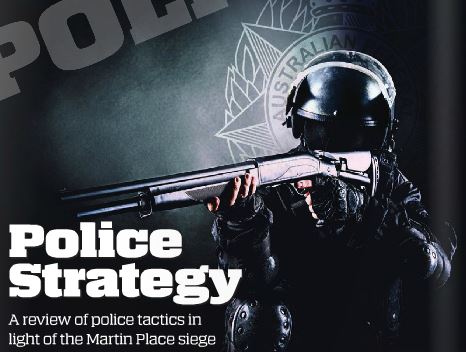
By Fraser Duff
The public may be very interested to have a more detailed appreciation of how the hostage incident could have ended without the loss of innocent lives.
I note an article which appeared in the Sydney Morning Herald on Tuesday seeking feedback on the tactics used by Police, citing support from a former Deputy Commissioner Clive Small. While the former Commissioner discounted the use of Police Marksman, the Police mindset on how best to respond to ideological terrorist affiliated individuals may need to change in view of the tragic event in Martin Place.
There are other viable options available to Police, which could have been used on the day including the use of Police Marksman. However, engaging these options would require a strong commitment and courage from the Commissioner of Police. I say this because there would be considerable political fallout and public criticism of senior Police and Politicians from some minority groups.
As a former founding member of the Tactical Operations Unit which carried out the Emergency Action response to recover the hostages, I have a detailed understanding of what options were available to Police on the day. This takes nothing away from the incredible courage of the officers who exposed themselves to extreme danger to protect the lives of the innocent. However it may challenge the conviction of Senior Police and Politicians.
The options available to Police are varied, but I will refer to the tactical options and I’ll explain them in detail so the public can be the judge of what they feel would be in the best interest of the innocent.
The most favoured Police option in a hostage situation is the Contain and Negotiate. This has been a very successful tactic for domestic related criminal type incidents i.e. hostage incidents and robberies gone wrong etc. It was developed in the 1980’s primarily through the FBI hostage negotiators to deal with incidents that were not necessarily ideologically and terrorist based. However with the rise of Al Qaeda and the September 11 attacks it is not adequate to put all your faith behind one approach at the exclusion of engaging other tactics. In a changing ideological environment with new and unique circumstances it is not necessarily going to produce the best outcome with terrorist minded individuals.
After September 11 the world changed, hostage takers were now consumed with the taking of innocent lives at whatever cost, while sacrificing their own for their beliefs and for martyrdom.
The Contain and Negotiate works very effectively when you have a person who is perhaps distraught and suffering mental illness, suicidal and possibly holding a family member or themselves hostage and threatening to cause themselves or others harm. They often need help, support and clarity in thinking and the Police negotiators can provide this support and achieve a peaceful resolution and have done so on many occasions.
However, 17 hostages and a fanatical ISIS ideology is a different equation and you can’t just apply the same model over and over again in the hope that it works in all circumstances. To do so would suggest a lack of situational appreciation.
With the rise of the “Islamic State” (ISIS), the world has changed even further in terms of terrorist incidents, but the Police Command may have not. If the predominant view is that we believe we can negotiate an outcome in such circumstances, then you need to consider; what ultimate outcome are fanatics really pursuing? Is a call to the prime minister and an Australian flag really what they are after when they align with ISIS….surely not.
In terms of Tactical Policing there are two options. The first is referred to as a Deliberate Option (DO): This option gives Police the greatest advantage as they make a decision to end the siege at a time of their choosing by engaging all tactics available to them including having marksman (sniper) and Police Assault Group coordinated actions. Police make a decision to end the siege which is planned, deliberate and rehearsed. In the case of a terrorist incident where hostages are taken and harm or death is imminent then this option affords Police the greatest tactical advantage and the hostages the greatest chance of survival. Marksmen can initiate the assault and create surprise and tactical advantage, which is then capitalized on with speed and accuracy.
If the media had a clear view of the gunman through the window, then more than likely the Police Marksman with their resources and the available intelligence (especially in light of the escaped hostages) would have an even better view of the gunman and he would be well covered with a range of specialist equipment and imagery. Police Marksman are exceptionally well trained and more than capable of successfully engaging a target from that short a distance even through safety glass with hostages in close proximity as documented by research. The engagement of the target via marksman affords the hostages the greatest chance of success, but it means the inevitable demise of the hostage taker and the associated political fallout.
I note that the Police Commanders and Politicians would not use the word ‘Terrorist’ in their discourse even though this individual openly displayed and declared his affiliation with ISIS. A group of Islamic radical fundamentalists who purport to kill any non believer; non Muslim or Muslim alike who doesn’t align with their ideology. After declaring his allegiance to this cause, the implications towards the hostages become far more significant. He even told the hostages he was going to kill them and one of the hostages was seen on TV drawing a finger across her throat to the cameras signaling in desperation what was inevitably going to happen. This is a desperate plea for help, signaling that the situation is now dire. It’s a virtual call of “please save us now before it’s too late”.
By continuing to treat this threat as a domestic hostage incident tactical police who were on standby were in my view ultimately deployed for the least desirable option. The option of last resort, which takes away any tactical advantage the Police Assault Group may have. This is the Emergency Action (EA) where the hostage taker starts killing / shooting hostages. At this point Police are coming off the back foot and have lost any advantage. They and the hostages are now exposed to the greatest level of risk as the Police scramble to try to gain entry and save the surviving hostages.
Why is it that innocent people have to die before we engage with deadly force? Why do we care so much about the hostage takers? Are their lives really more important than the hostages? It’s not about being right…it’s about doing the right thing in such circumstances to protect the innocent regardless, that’s our commitment to them.
If an incident is declared a terrorist incident then more options become available to the state to resolve the matter, including engagement of the military. Their tactics are to use deadly force and they will engage with a Deliberate Option Plan and have their Emergency Action in waiting until they are ready to strike. This option has without a doubt the highest chance of success for saving lives where death is imminent. This act however requires the Commissioner to hand over control to the military commanders.
No State Tactical Police Team would ever consider their capability to be comparable to that of the military for this type of operation. The military develop all the tactics and help in training the Police. They specialise in these operations and train day after day until they can do it with their eyes closed. They measure success on how many lives are saved through executing speed, precision and accuracy.
I firmly believe from experience that the Martin Place incident could have ended with all hostages alive, as opposed to the unfortunate circumstance whereby two innocent people lost their lives. It seems we are more intent on protecting the hostage taker from meeting a violent end. The Commissioner was not prepared or perhaps, with the limitations established by current thinking, able to realize the threat, including it’s probable implications to the lives of the hostages and act accordingly.
The all important question now is would the same decision making frameworks be applied to future incidents? Critical reflections must accompany this incident. Detailed review of decision making and the logic applied to deductive reasoning for situations that reflect the current and future environment must all be re-considered. Hard questions will need to be discussed and less popular options considered to ensure key lessons are learnt. The Commissioner can’t afford to be content with current thinking if the end result only duplicates what has just been experienced.
In terms of providing another perspective aside from that of Clive Small as reported by the Sydney Morning Herald with respect to the use of snipers. I’d like to highlight some very interesting research that was collated with the assistance of a colleague of mine, himself a previous police officer and designated police marksman. Central to the discussion about whether a sniper option can be credibly considered, and to assist efforts for future strategies, it is worthwhile highlighting the researched results from studies on rifle bullet deflection against commercially tempered glass. A 1994 study was carried out as a thesis presented to the Faculty of the Department of Criminal Justice at California State University and utilising facilities, equipment and ammunition courtesy of Edwards Air Force Base Combat Arms Training branch. All results published. The study used a.308 calibre (marksman) ammunition fired against 1/4 inch tempered glass.
Ammunition can have many different design characteristics. Figures related to this study were carried out on full metal jacketed rounds (including comparisons to soft point and hollow point rounds). Other rounds exist that are more capable of penetration without these deflection, deformation and fragmentation issues.
The equipment augers well as a good comparison perhaps to the scenario at Martin Place. There are finer points regarding round jacket and core separation, loss of velocity, deflection and fragmentation spread, but the summary I’ll recite gives quite a comparative picture.
Findings confirm firstly at distances anywhere between 4 metres and 100 metres separation between the shooter and glass, that the rates of deflection, deformation etc are all consistent. Assuming that this was an equivalent range (unlikely a marksman will be firstly firing through glass immediately in front of their position) – these findings will apply.
So long as the distance between the target and the glass is within 5 metres, then again, these statistics can be considered to apply. Basic result – The Bullet is stable and will produce consistent and predictable groups under 5 inches in diameter at 5 metres glass-target distance. A quote from the research author, “If a marksman had to make a shot where the available target area is small, a 90 degree shot would result in an accurate and predictable impact. A preliminary shot to eliminate glass would not be necessary.”
Furthermore the bullet is predictable at all strike angles between 45 degrees and 90 degrees – with differing predictable effects based on the angle of strike. Firing 90 degrees to the glass (straight on) has produced consistent figures (with variables taken into consideration) of a core deflection of .59 inches (at 5 metres glass-target) with a lethal circle (fragments incorporated) of 2.94 inches.
This is certainly giving credence to the acceptability of a marksman option if these angles, distances etc were presented. Beyond the anecdotal, it’s scientific studies on rounds and predictable effects on glass that best inform the sniper option.
I think you’ll agree that the opportunity to employ a Marksman option would have been a very realistic option in the Martin Place incident, by either the Police or Military with due consideration to the likely impact of a round on glass in varying conditions as cited above (despite what others say). Due to its broader arc, lethal fragmentation is the only real concern, and this is only really a factor if hostages are within very close proximity. At a tactical level, consideration needs to be given as to whether to use an orchestrated 1st and 2nd Marksman shot or single Marksman. The penetration research indicates that, subject to angles and distance, a coordinated and simultaneous multiple marksman option may not have been critical to the success of the outcome even though it would be preferable to further support success for the most important outcome of all – to save the lives of all hostages. (i.e., immediately immobilizing the threat to best minimize further harm to innocent hostages).






